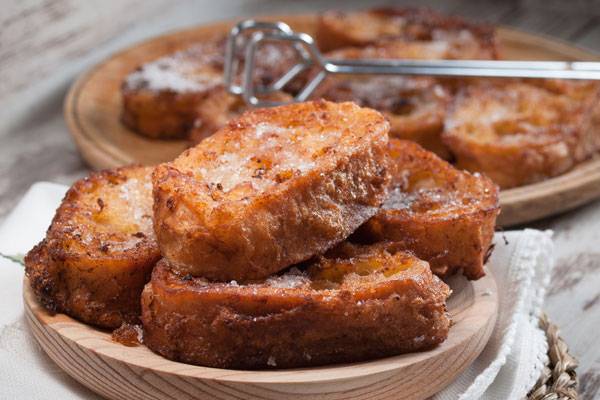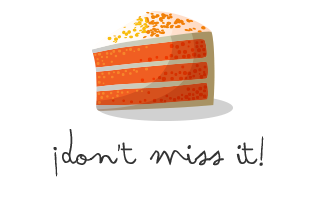Typical Easter meals
That’s good enough to eat
Holy Week in Spain, as well as being one of the most important religious and traditional festivals, also brings culinary memories to mind for almost everyone. Who hasn’t tried the “Mona de Pascua”? Or “torrijas”?
TOPIC OF THE MONTH
Share
After the long period of Lent, Holy Week becomes a time of celebration which, throughout much of the country, revolves around our traditional recipes. Almost all of them are based, thanks to history and tradition, on the habits of abstinence of yesteryear.
Although this is a time of religion and recollection, Holy Week is also time to meet with the family. During this holiday, we usually spend our time around a table replete with the sweetest delicacies, while not forgetting to leave room for other dishes that often have nothing to do with the abstinence from meat proposed by Catholic Lent.
Thus, according to the area in which we find ourselves, we may be eating one typical dish or another. For example, in the regions of Catalonia, Aragon, the Valencian Community and Murcia, the Monas de Pascua are typical; In Andalusia, pestiños (honey fritters) and hornazos (pasties); As well as the traditional Spanish dishes, such as garlic soup, typical of northern Spain or the vigilant’s soup, made with salted cod, which is cooked in many places throughout the country.
THE MONA DE PASCUA
The tradition of this Easter cake goes back to the fifteenth century, when every Easter Monday there was a tradition that godparents would give their godchildren the Mona (munna in Arabic, which means a gift). The story tells that it was eaten outdoors, in the countryside, along with a myriad of dishes, including plenty of grilled meat.
In its beginnings, the Mona was simply a round pancake that was baked in different shapes and carried a hard-boiled egg in the centre. Today, this cake has developed into a chocolate figure, especially in the area of Catalonia, where the real star of the mona is its decoration. The motifs used are varied and usually revolve around the most important children's characters, although there are also some more demanding Monas.
Nowadays, Monas de Pascua have evolved into real works of art.
Make your own Mona de Pascua Ingredients: - 8 eggs - 25 gr powdered yeast - 125 ml milk -1 glass of anise -40 gr sugar -1 pinch of powdered cinnamon -500 gr flour (or less) - ½ glass of oil Method: Break 6 of the eggs, separating the yolks from the whites, and beat the egg whites. Add the warm milk, in which the yeast, oil, anise, sugar and cinnamon will have been dissolved; Then add as much flour as can be absorbed by the mix, and knead well, making 2 equal parts; With these you will make the dough, which you should leave to ferment for two hours, covered with a cloth and in a warm place. Cook the remaining 2 eggs, and when the buns are ready, place each of them in the centre of the dough, or one in each corner, to your liking. Arrange the Monas on a tray and cook in the oven at a medium temperature until golden. You can cover the Mona with melted chocolate and decorate it with chocolate figurines. |
EASTER SAUSAGE
Who has not heard of the Longaniza de Pascua, or traditional sausage? Originally from the Valencian Community, this is a type of cured sausage that always accompanies the Mona during Easter week, although we can find it all year round in the butchers and in specialised stores.
It is a cured sausage made with lean, chopped pork bacon, as well as spices. This paste is then stuffed into a narrow gut to form a sausage of about 18-20 centimetres, which is dried for about 15 days, leaving it less dry than other cured sausages. The sweet ‘n’ sour combination of the Mona and the Longaniza, is not to be missed.
EASTER EGGS
The tradition of giving eggs at Easter also originated in the Middle Ages, when Christians could not eat eggs because of Lenten abstinence. To keep the eggs fresh until Easter came, they bathed them in a thin layer of liquid wax and stored them like this. When Lent was over, they would gather in the church and give them to their loved ones.
Although today the Catholic Church only recommends abstaining from eating meat on Good Friday, the tradition of giving eggs continues, especially in Anglo-Saxon countries and Central Europe. In Spain, giving eggs is always linked to the Easter Mona and often eggs are decorated and even made straight out of chocolate, making them more attractive to children.
Learn how to decorate Easter eggs! Let's take advantage of these days off to teach the children some crafts to do with eggs. They will have fun, be entertained and can let their imagination take flight. 1. Empty the eggs: with a pin, make a hole in the base and one in the top. Shake it a little and then lay the egg on top of a glass and blow into it to empty it. Being careful not to break the shells, clean them and let them dry. 2. Paint them: with felt-tip pens, waxes, tempera, glitter, and even with felt accessories. Anything goes when creating a great egg! Put all the materials on a table and let the children make their own designs. |
DELICIOUS TORRIJAS
Undoubtedly, a very traditional dessert at this time of year is torrijas, similar to French toast. A simple delicacy made basically with bread, which lends itself to multiple combinations. Its secret is to use thick slices of bread from the previous day, soak them a little (not too much) in sugared milk, drain, dip them in beaten egg and fry in very hot oil. They are spectacular!
And to complete this delicious snack, simply coat them with a little sugar and cinnamon. This seasoning gives them a very special touch.

BUT MAN CANNOT LIVE ON SUGAR ALONE…
The Easter season is characterised by its typical desserts, but the tradition of hot stews and soups is also widespread in our country.
These are recipes with many centuries of history behind them, which have survived intact to this day. Just as the Monas were used as a supplement for not being able to eat meat, stews and soups were also made for the same purpose.
In the north, to combat the harsh cold, garlic soup is typical. It is made with crumbs of stale bread that gradually soften on the plate next to a poached egg, all seasoned with paprika. A simple, tasty soup that is still served today in the best restaurants.
Another dish that is very much associated with these dates is the “vigilant’s” stew. It is so called because of its main ingredient, cod, which was formerly used as a substitute for meat during Lent. It is a very complete stew thanks to the quality of its ingredients: cod, spinach, egg and chickpeas.







 ¡Subscribed!
¡Subscribed!